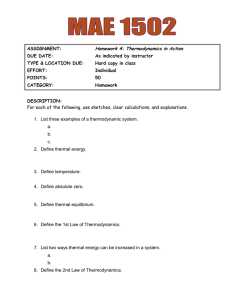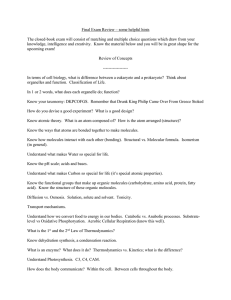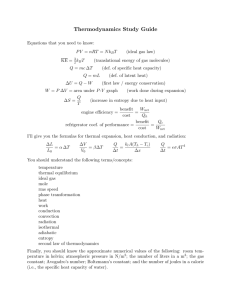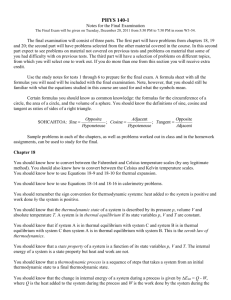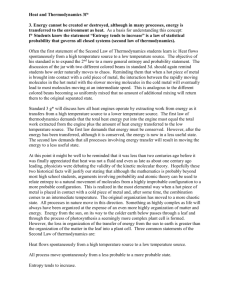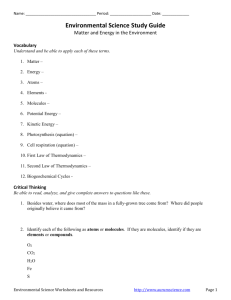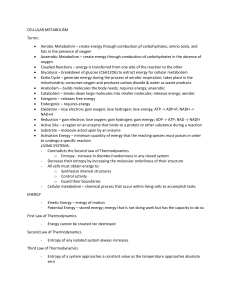AP Physics 2 - AJRomanello
advertisement
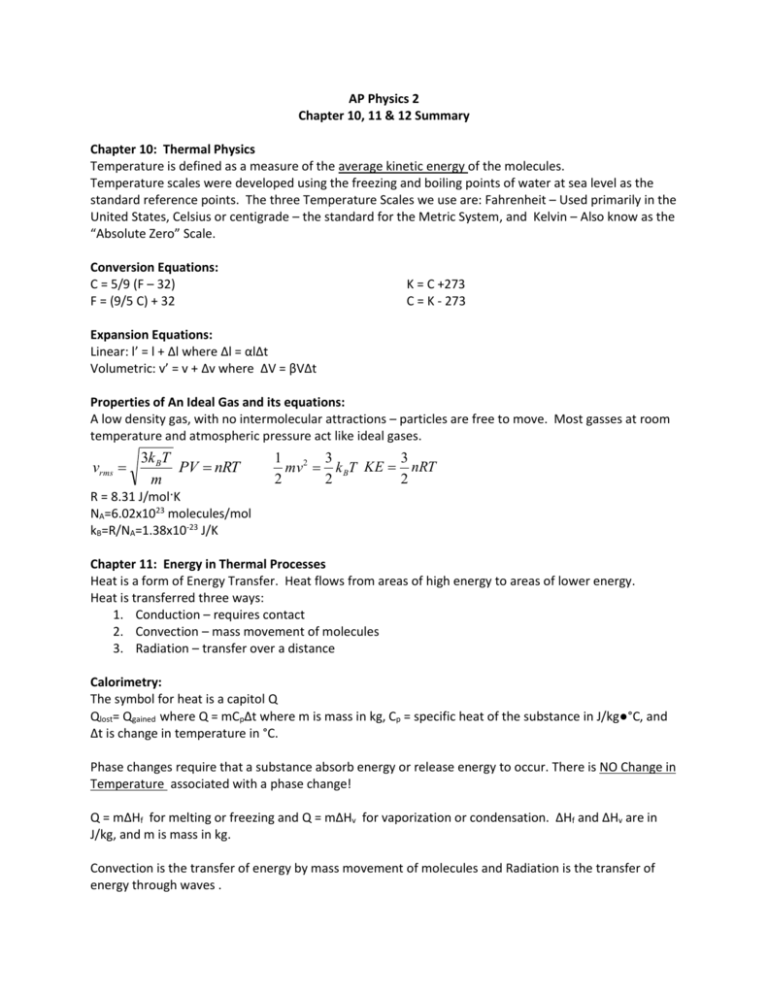
AP Physics 2 Chapter 10, 11 & 12 Summary Chapter 10: Thermal Physics Temperature is defined as a measure of the average kinetic energy of the molecules. Temperature scales were developed using the freezing and boiling points of water at sea level as the standard reference points. The three Temperature Scales we use are: Fahrenheit – Used primarily in the United States, Celsius or centigrade – the standard for the Metric System, and Kelvin – Also know as the “Absolute Zero” Scale. Conversion Equations: C = 5/9 (F – 32) F = (9/5 C) + 32 K = C +273 C = K - 273 Expansion Equations: Linear: l’ = l + Δl where Δl = αlΔt Volumetric: v’ = v + Δv where ΔV = βVΔt Properties of An Ideal Gas and its equations: A low density gas, with no intermolecular attractions – particles are free to move. Most gasses at room temperature and atmospheric pressure act like ideal gases. vrms 3k BT PV nRT m 3 1 2 3 mv k BT KE nRT 2 2 2 R = 8.31 J/mol·K NA=6.02x1023 molecules/mol kB=R/NA=1.38x10-23 J/K Chapter 11: Energy in Thermal Processes Heat is a form of Energy Transfer. Heat flows from areas of high energy to areas of lower energy. Heat is transferred three ways: 1. Conduction – requires contact 2. Convection – mass movement of molecules 3. Radiation – transfer over a distance Calorimetry: The symbol for heat is a capitol Q Qlost= Qgained where Q = mCpΔt where m is mass in kg, Cp = specific heat of the substance in J/kg●°C, and Δt is change in temperature in °C. Phase changes require that a substance absorb energy or release energy to occur. There is NO Change in Temperature associated with a phase change! Q = mΔHf for melting or freezing and Q = mΔHv for vaporization or condensation. ΔHf and ΔHv are in J/kg, and m is mass in kg. Convection is the transfer of energy by mass movement of molecules and Radiation is the transfer of energy through waves . Chapter 12: Laws of Thermodynamics W = -PΔV where P is the pressure throughout the Gas and ΔV is the change in volume during the process. In a Pressure Volume Diagram the area under the graph is equal in magnitude to the work done on the gas ΔU = Q + W where ΔU is the change in internal energy, Q is the energy added to the gas by way of heat, and W is the work done on the gas. There are three thermal processes of interest: 1. Adiabatic Processes – No energy leaves the system by heat so ΔU = W 2. Isovolumetric Processes – Proceeds at constant volume – hence no work is done so ΔU = Q 3. Isothermal Processes – Temperature of the system doesn’t change so W = -Q The Second Law of Thermodynamics Heat can never pass spontaneously from a colder to a hotter body. As a result of this fact, natural processes that involve energy transfer must have one direction, and all natural processes are irreversible. This law also predicts that the entropy of an isolated system always increases with time. Entropy is the measure of the disorder or randomness of energy and matter in a system. Because of the second law of thermodynamics both energy and matter in the Universe are becoming less useful as time goes on.

